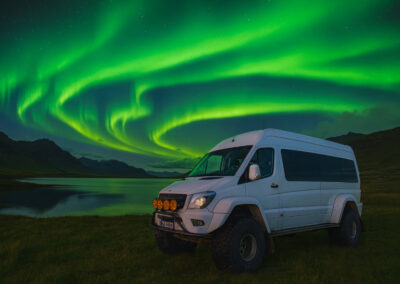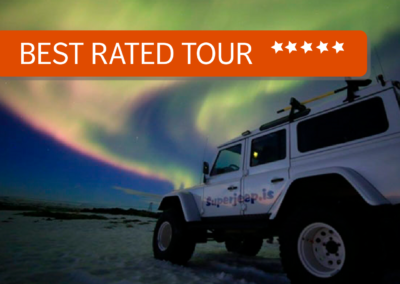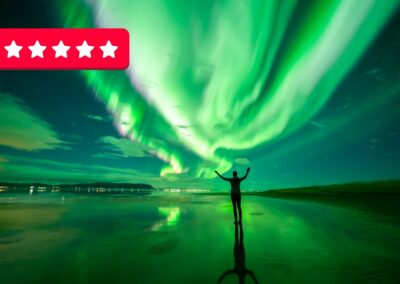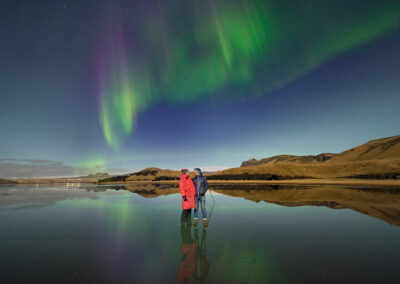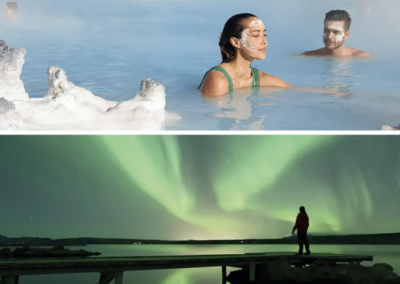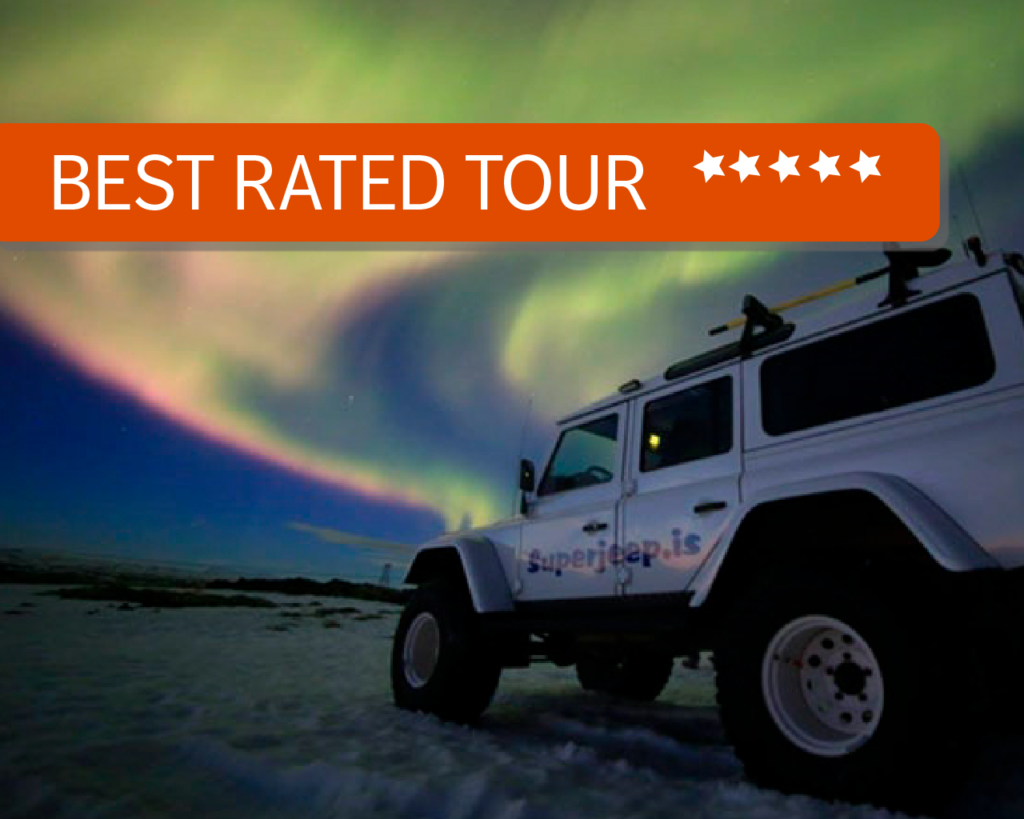LA GUÍA DEFINITIVA PARA VER LAS AURORAS BOREALES EN ISLANDIA EN 2024/25
Mejores momentos
Mejores lugares
Mejores tours
Quizás no haya nada más mágico que presenciar la belleza de un espectáculo de Auroras Boreales, y ha sido el sueño de toda una vida para muchos. Sin embargo, esas luces impredecibles, siempre danzantes, no siempre aparecen cuando se les llama.
¡Aquí tienes todo lo que necesitas saber para hacer realidad tu sueño de ver la aurora!
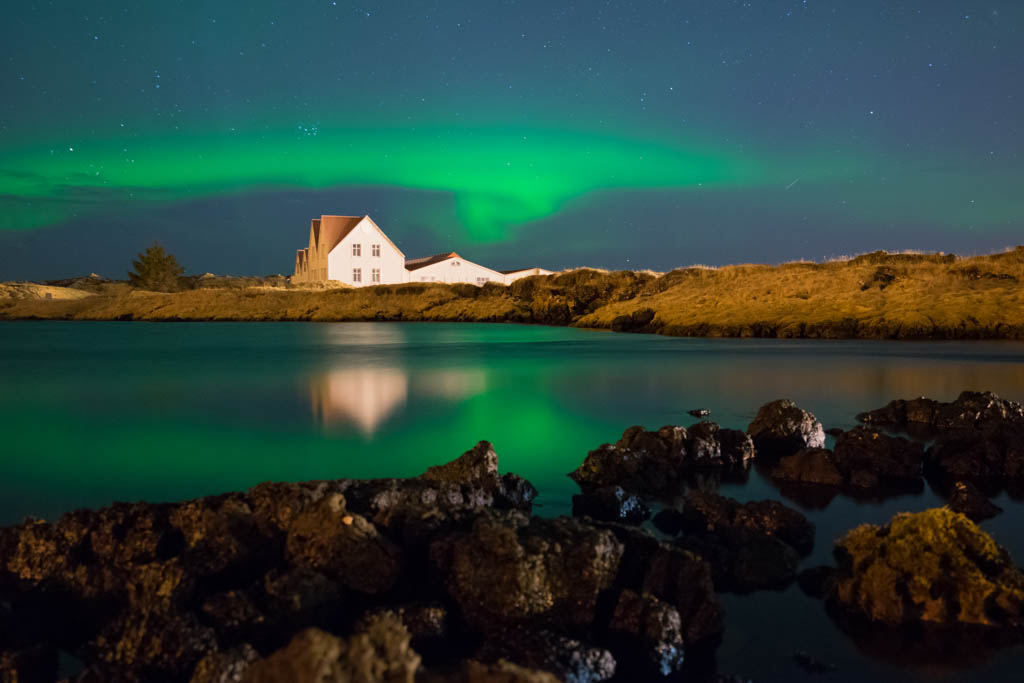
Auroras Boreales en Straumur, una antigua granja cerca de Reikiavik
¿Qué son las Auroras Boreales?
¿Cuál es el mejor momento para ver Auroras Boreales?
Mejores formas de ver la Aurora Boreal en Islandia
¿Cuáles son mis posibilidades de ver las auroras y cómo puedo aumentarlas?
Mejores lugares para ver la Aurora Boreal en Islandia
¿Qué tengo que llevar para mi aventura con las auroras boreales?
Witnessing the Northern Lights in Iceland requires knowledge, patience and a little bit of luck. For catching a beautiful display, you will need a few factors in your favor:
- darkness,
- clear skies (or openings in the cloud cover),
- good solar activity (usually the case over Iceland),
- little to no light pollution.
Oscuridad
To see the Northern Lights, darkness is required – making the hunt for the lights a night-time activity. From the end of August to mid-April, the skies are dark enough to witness auroral displays in Iceland.
Clear skies
The Northern Lights occur above our weather system; therefore, clouds can spoil the visibility. The Northern Lights forecast offers a regularly updated prediction for total cloud cover over the country. As weather and wind direction change fast in Iceland, conditions are almost unpredictable at times, and tour operators often decide in the late afternoon whether factors are favorable enough to head out for the night hunt. If you go on your own, check where chances for clear skies are best right before you start your Aurora adventure.
Actividad solar
The strength of an auroral display depends on the solar activity, which is measured with the so-called KP index, ranging from 0 to 9. The higher the number on the scale, the higher the auroral activity and the better your chances of witnessing fast dancing lights in various colors. However, the Sun is constantly emitting solar particles, and even a low or moderate KP (2 or 3) is usually enough to experience good Northern Lights over Iceland.
Keep in mind that the index offers a forecast, but no guarantee that the Northern Lights will occur at any given time.
We have witnessed nights with a predicted KP7 and absolutely no lights, and even more often nights with a predicted KP 2 and lights dancing across the sky. If skies are clear, head out – no matter the KP.
You can monitor the KP index aquí.
Light pollution
The further away you get from any source of light pollution, the better your chances of seeing the Aurora Borealis are. Leave the city behind and immerse yourself in the vast and rugged Icelandic nature – that’s where the real adventure starts!
Pro-tip: Keep in mind that the Moon creates light pollution too. If you are hoping to experience the Northern Lights at their best, we highly recommend choosing a period with little to no Moon.
The most common auroral color is green, but colors can vary from white, green, pink and purple, depending on the elements being ionized.
The Northern Lights appear in the polar regions, in the so-called auroral oval.
Located straight in the middle of this oval, Iceland is the perfect destination for observing the Northern Lights.
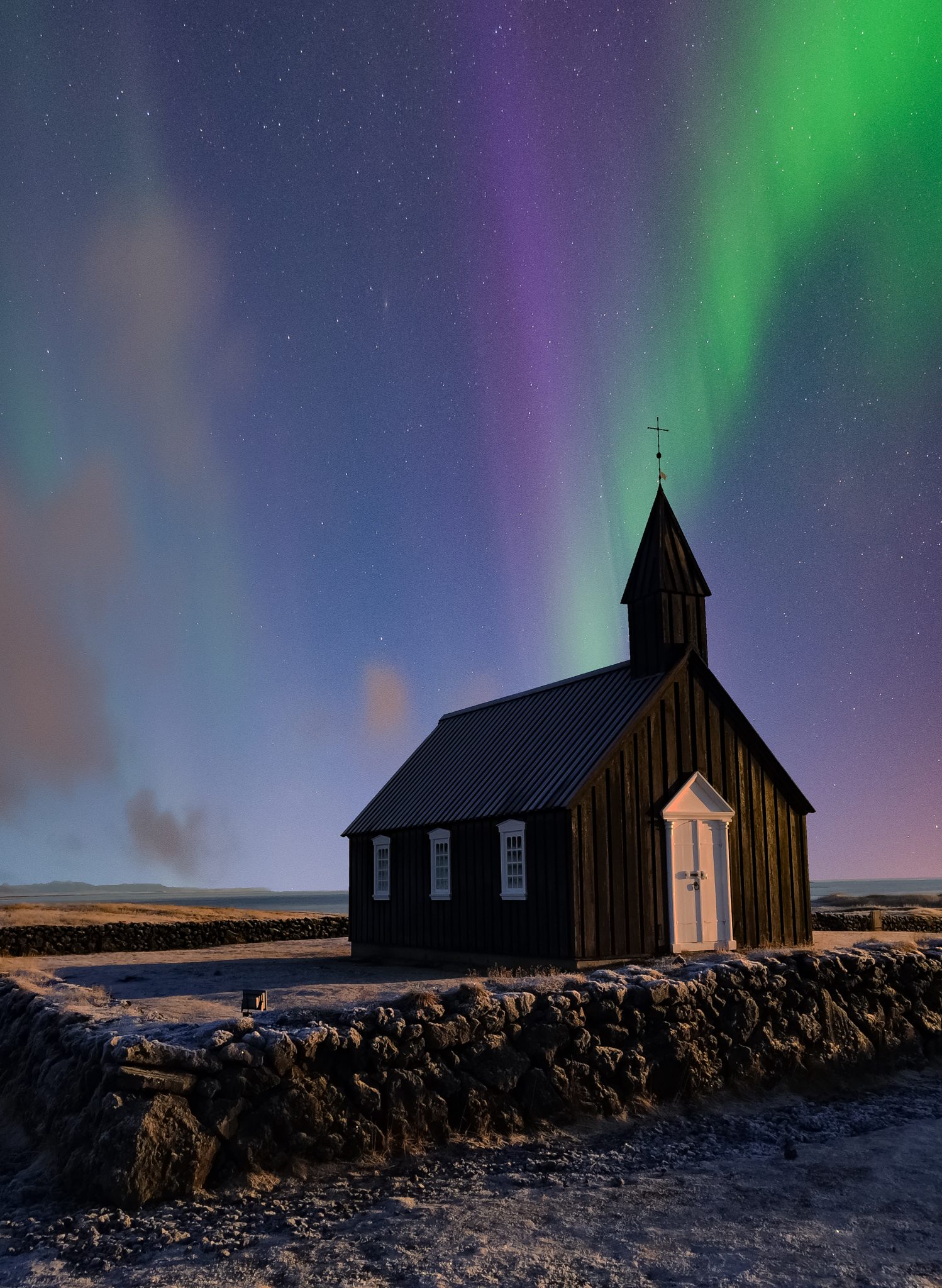
Aurora Boreal en Búðir
¿Cuál es el mejor momento para ver Auroras Boreales?
In Iceland, the Aurora season starts in late August and ends around mid-April. Any time during this period is favorable and has its advantages.
Statistically, the Aurora is most often seen around the equinoxes in September/October and March/April.
Como fotógrafos de auroras boreales, personalmente nos encanta septiembre/octubre – aquí te contamos por qué.
Cómo ver la Aurora Boreal en Islandia
Tienes varias opciones para ver las Auroras Boreales en Islandia:
- Buscar Auroras Boreales en Reikiavik,
- Unirte a un tour guiado,
- Alquilar un coche y cazar por tu cuenta,
- Tomar un crucero nocturno para ver las auroras boreales.
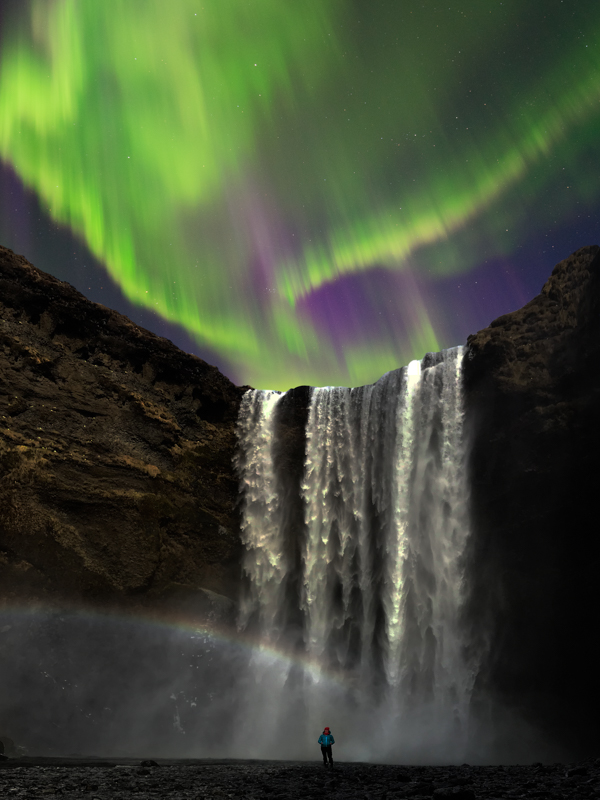
Aurora Boreal en Skógafoss
Hunting the Northern Lights in Reykjavik
“Can you see the Aurora from the city?” is a frequent question of hopeful Aurora hunters. The answer: yes, you can – if conditions are favorable.
However, the experience will not be as rewarding as it can be when you leave the city lights behind and head out into the arctic wilderness. We often compare it to watching a movie at the cinema with all the lights switched on. Dust and electrical illumination make it hard to see the auroral lights, so your eyes will process them rather faint and not as colorful.
That being said, if budget is a concern, you can always try to catch the Aurora from around town.
Encuentra aquí los mejores lugares para ver la Aurora Boreal en Reikiavik.
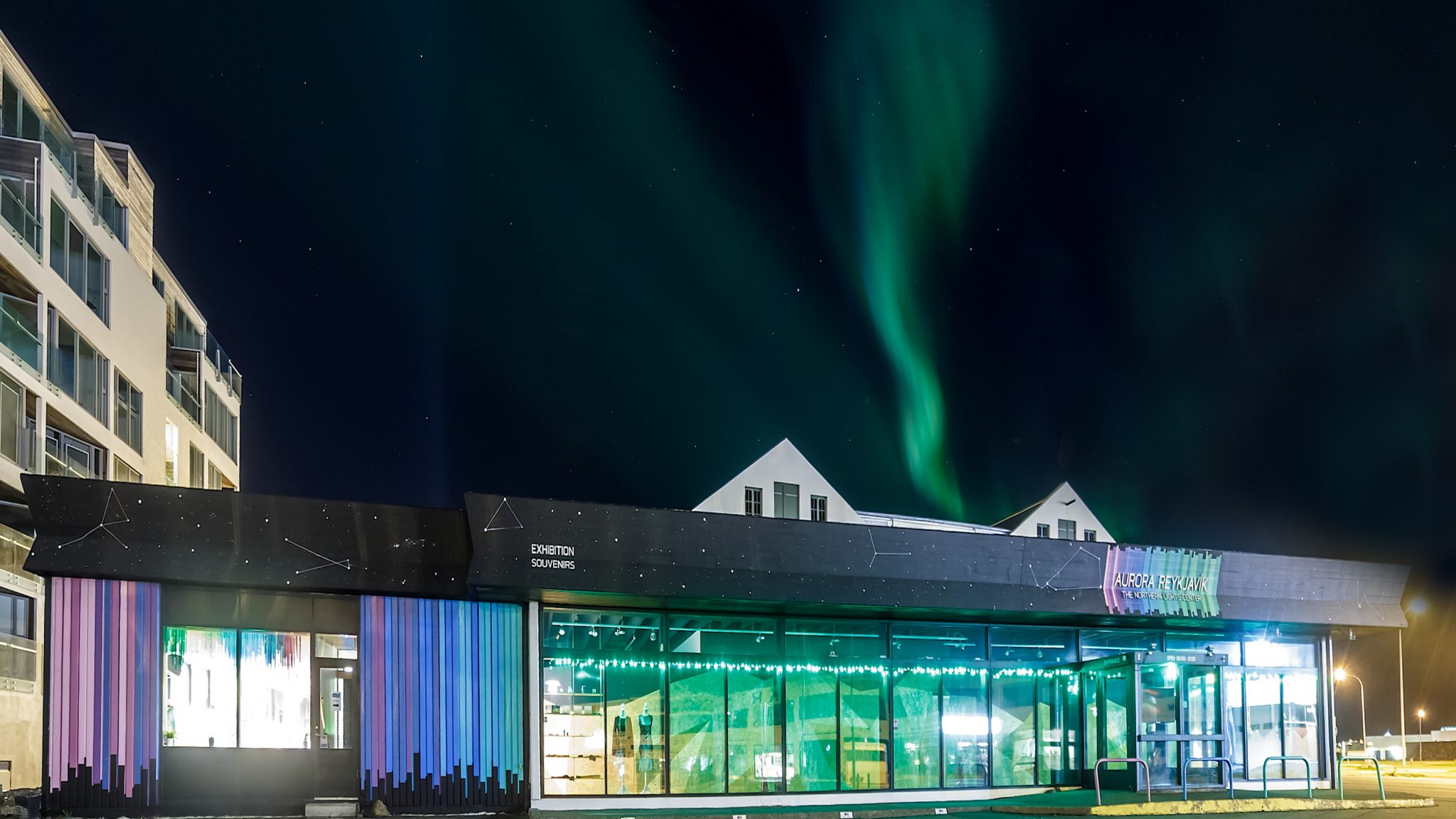
Aurora Boreal sobre Aurora Reykjavík
Unirse a un tour guiado de Auroras Boreales
La forma más común de buscar la Aurora Boreal es realizar una excursión guiada. Varios operadores turísticos organizan excursiones regularmente desde septiembre hasta abril, ofreciendo una amplia variedad de tours para todos los presupuestos y preferencias personales:
- tours en autobús y minibús,
- tours en superjeep,
- tours fotográficos,
- tours privados,
- y una variedad de tours en combo que vale la pena considerar
Tan impredecible como puede ser la Aurora, los operadores turísticos hacen todo lo posible para que puedas verla y convertirla en una experiencia verdaderamente única. Si tu tour se cancela debido a condiciones meteorológicas desfavorables o no se logran ver las luces, tendrás la oportunidad de reprogramarlo o intentarlo de nuevo sin coste adicional.
Unirse a una visita guiada suele ser una elección acertada por varias razones:
- Estarás bajo la guía de un experto que sabe dónde encontrar las luces y cómo fotografiarlas,
- Podrás llegar fácilmente a zonas donde la previsión sea más prometedora,
- Viajarás con personas que comparten tus mismos intereses,
- No tendrás que preocuparte por conducir en las duras condiciones invernales de Islandia.
Aquellos con un presupuesto ajustado apreciarán los tours en autobús a precios razonables, que te llevarán a la búsqueda de las luces sin gastar demasiado.
Los tours en minibús ofrecen una experiencia de grupo reducido y, a menudo, incluyen extras valiosos como bebidas calientes a bordo o fotos tuyas bajo las Auroras Boreales tomadas por tu guía experto. Estas excursiones se realizan en vehículos más pequeños que los tours regulares en autobús, lo que permite mayor flexibilidad al buscar el lugar ideal para ver la Aurora.
Si quieres convertir tu búsqueda de las Auroras Boreales en una experiencia única en la vida, te recomendamos encarecidamente elegir un tour en super jeep. Estas excursiones ofrecen, sin duda, la experiencia más personal e inmersiva y las mayores posibilidades de presenciar un espectáculo espectacular, a menudo fuera de los caminos habituales.
Puedes encontrar nuestros tours favoritos aquí.
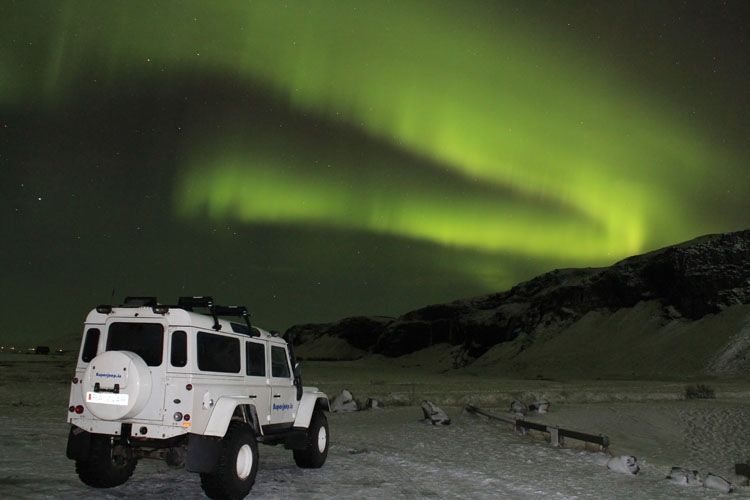
Foto de nuestro popular tour en Superjeep para ver las Auroras Boreales
Unirte a un crucero nocturno de Auroras Boreales
Otra forma de vivir una experiencia inolvidable con las Auroras Boreales es unirse a un crucero nocturno para ver la Aurora. Los cruceros están diseñados para ofrecer comodidad, con áreas interiores calefactadas que incluyen un bar y aseos, además de monos térmicos disponibles para observar las Auroras desde las cubiertas.
Ten en cuenta que los barcos no ofrecen el mismo grado de movilidad que los tours en autobús o jeep, y debido al movimiento del barco, fotografiar las Auroras con configuraciones de larga exposición puede resultar complicado.
La principal fortaleza de un crucero para ver las Auroras Boreales no es tanto la "búsqueda" de las luces en sí, sino la experiencia de estar en el mar, los paisajes encantadores y las impresionantes vistas del horizonte de Reykjavík o Akureyri bajo la Aurora.
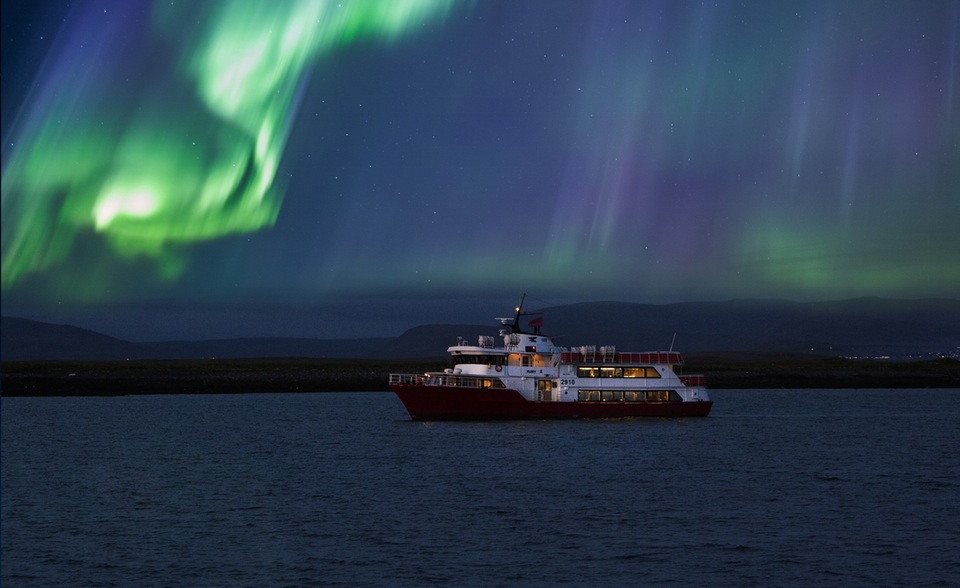
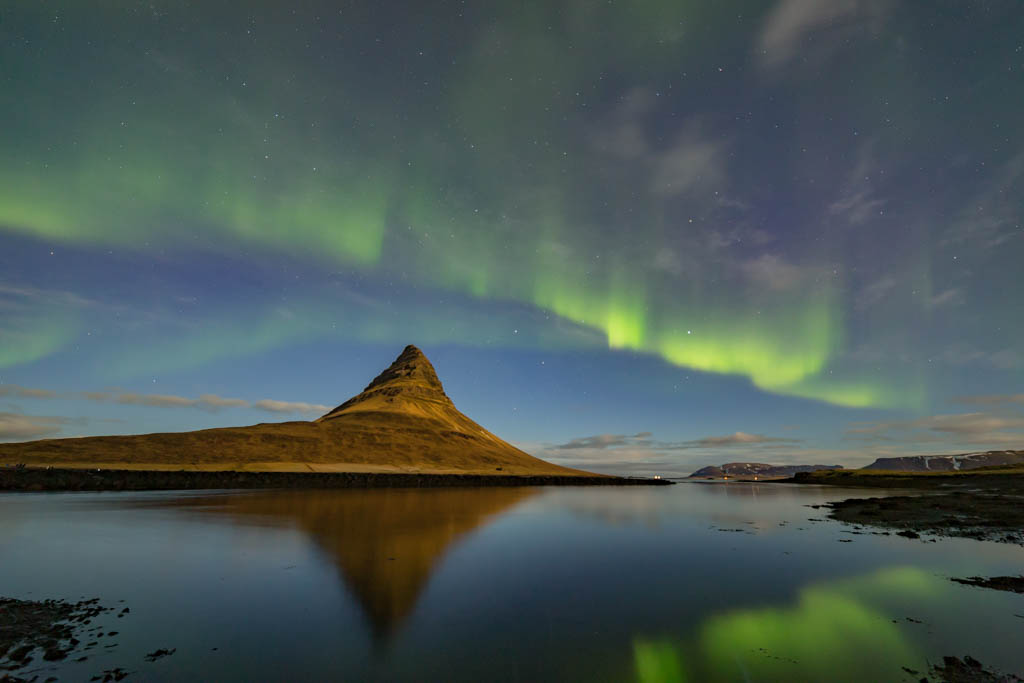
Aurora Boreal en Kirkjufell
¿Cuáles son mis posibilidades de ver las auroras y cómo puedo aumentarlas?
El Sol emite constantemente plasma, y las posibilidades de ver las Auroras Boreales suelen ser bastante buenas si tienes en cuenta algunos puntos:
1. Considera un tour guiado con un guía experimentado
La búsqueda de las Auroras Boreales puede ser complicada, por lo que te recomendamos encarecidamente confiar en el conocimiento y la experiencia de un guía turístico local. A menudo, la gente no logra ver las luces por razones muy simples, como estar en el lado equivocado de una cordillera, mientras las luces bailan alegremente escondidas detrás de los picos.
2. Planea la longitud de tu estancia en Islandia con sabiduría
Las Auroras Boreales tienden a ser muy activas durante 2-3 noches, seguidas de 4-5 noches más tranquilas, en ciclos continuos. Cuanto más larga sea tu estancia, mayores serán tus posibilidades de verlas.
3. Reserva tu tour para el primer día de tu estancia
Si tu tour se cancela en la primera noche disponible debido a condiciones meteorológicas desfavorables o no logras ver las luces, todavía tendrás tiempo para reprogramarlo o aprovechar tu segundo intento gratuito. Y, aunque tengas suerte y las veas en tu primer tour, ¡quizá quieras intentarlo de nuevo por tu cuenta las noches siguientes!
4. La paciencia es la clave
Las Auroras Boreales tienden a aparecer alrededor de la medianoche magnética, lo que equivale a las 11 p. m. en horario islandés. Sin embargo, pueden ocurrir en cualquier momento, siempre que haya oscuridad. Abrígate bien, prepara un termo de chocolate caliente y una manta, ¡y prepárate para una larga noche bajo el cielo ártico!
Mejores lugares para ver la Aurora Boreal en Islandia
Chances to see the Northern Lights are about the same all over Iceland, due to its ideal location under the auroral oval.
It is all a matter of clear and dark skies, so any place away from light pollution and clouds is potentially fine at these latitudes.
However, here are our personal recommendations:
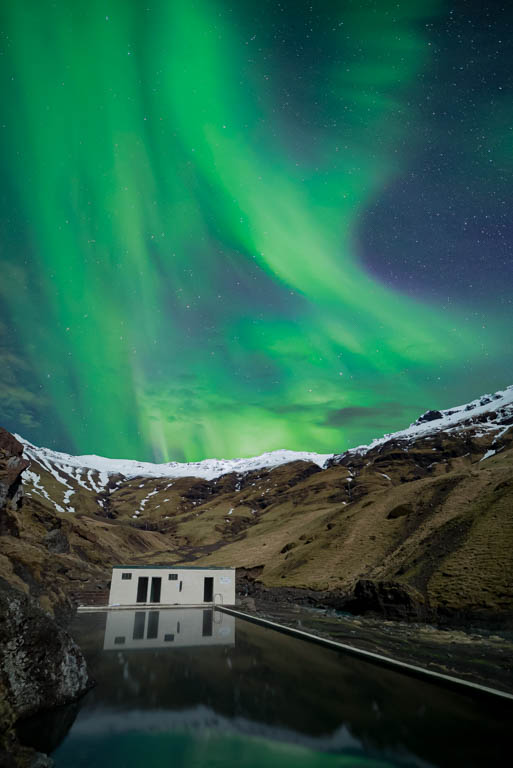
Aurora Boreal en Seljavallalaug
- Estar junto a un lago que no está congelado, como Þingvellir, ofrece la oportunidad de presenciar reflejos increíbles.
- El Blue Lagoon no solo es un lugar perfecto para darse un relajante baño, sino también para observar algunas hermosas exhibiciones aurorales.
- Las innumerables cascadas en la costa sur de Islandia, como Skógafoss, crean un escenario perfecto como primer plano para impresionantes fotografías de auroras boreales.
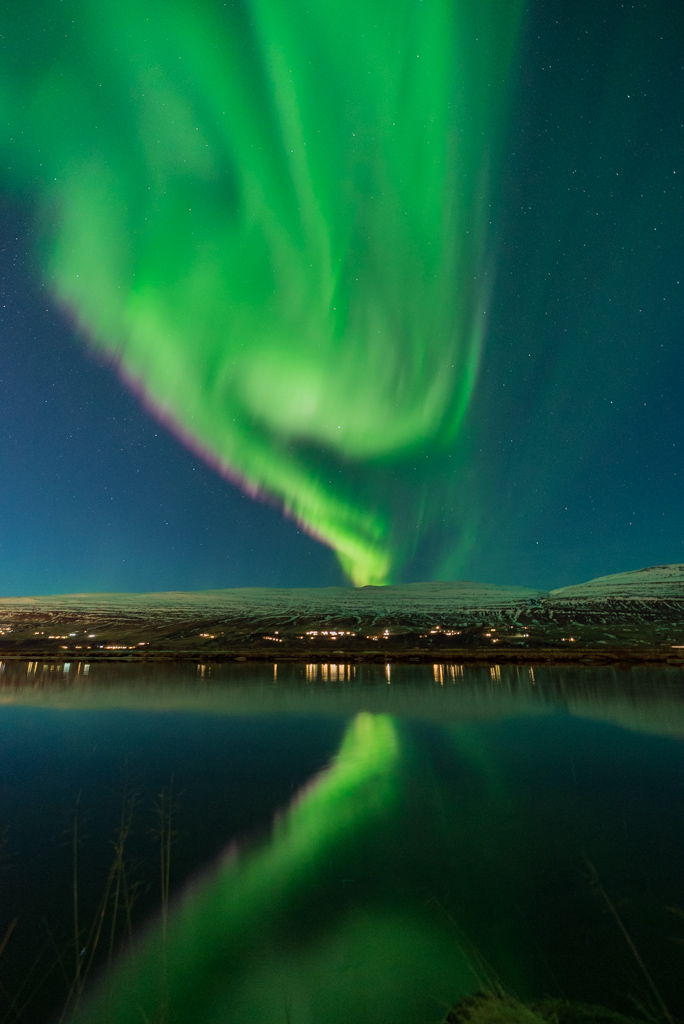
Aurora Boreal en Akureyri
What to bring for a Northern Lights adventure
Here are some essentials to make your Northern Lights hunt a great experience:
- Warm, wind- and waterproof clothes – dress preferably in layers,
- Warm and steady shoes,
- Thermos bottle with hot drinks,
- Snacks,
- Hand- and toe warmers,
- Headlamp, ideally with red light.
For photographing, you will need:
- Camera or phone with manual mode settings,
- Tripod,
- Baterías de recambio
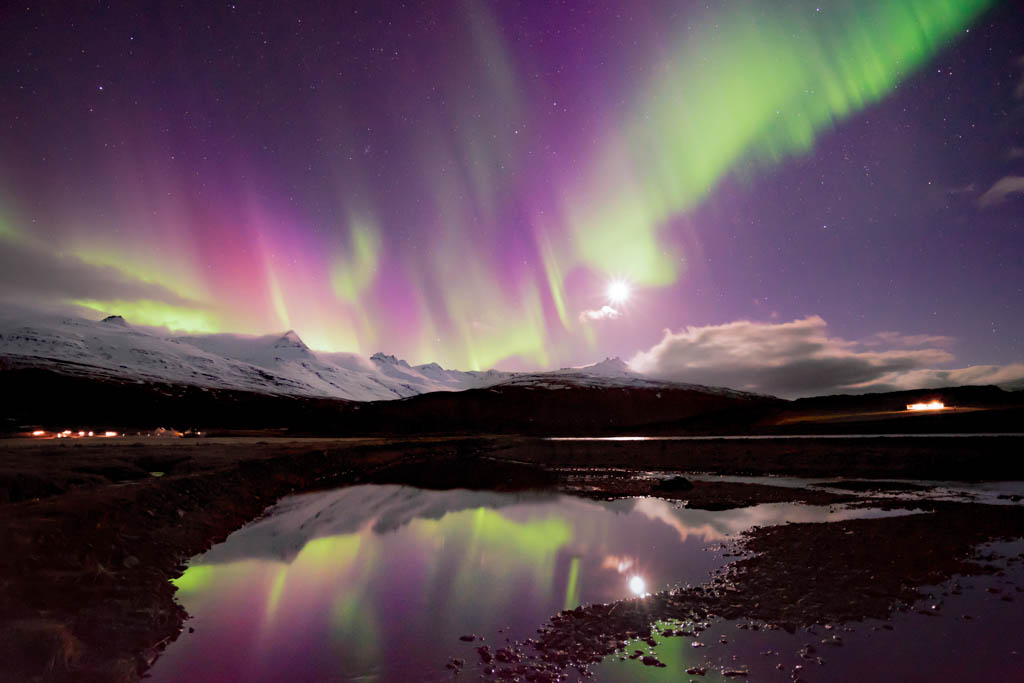
Los lagos y estanques crean hermosos reflejos.
Cómo fotografiar las Auroras Boreales
- Use a Tripod: A stable camera is essential for long exposures.
- Wide-Angle Lens: Capture as much of the sky as possible.
- Manual Settings: Start with an aperture of f/2.8, ISO 1600, and a shutter speed of 10-15 seconds. Adjust as needed.
- Foreground Interest: Include mountains, waterfalls, or trees to create compelling compositions.
Para una guía detallada de fotografía, lee nuestros Consejos para fotografiar auroras boreales.
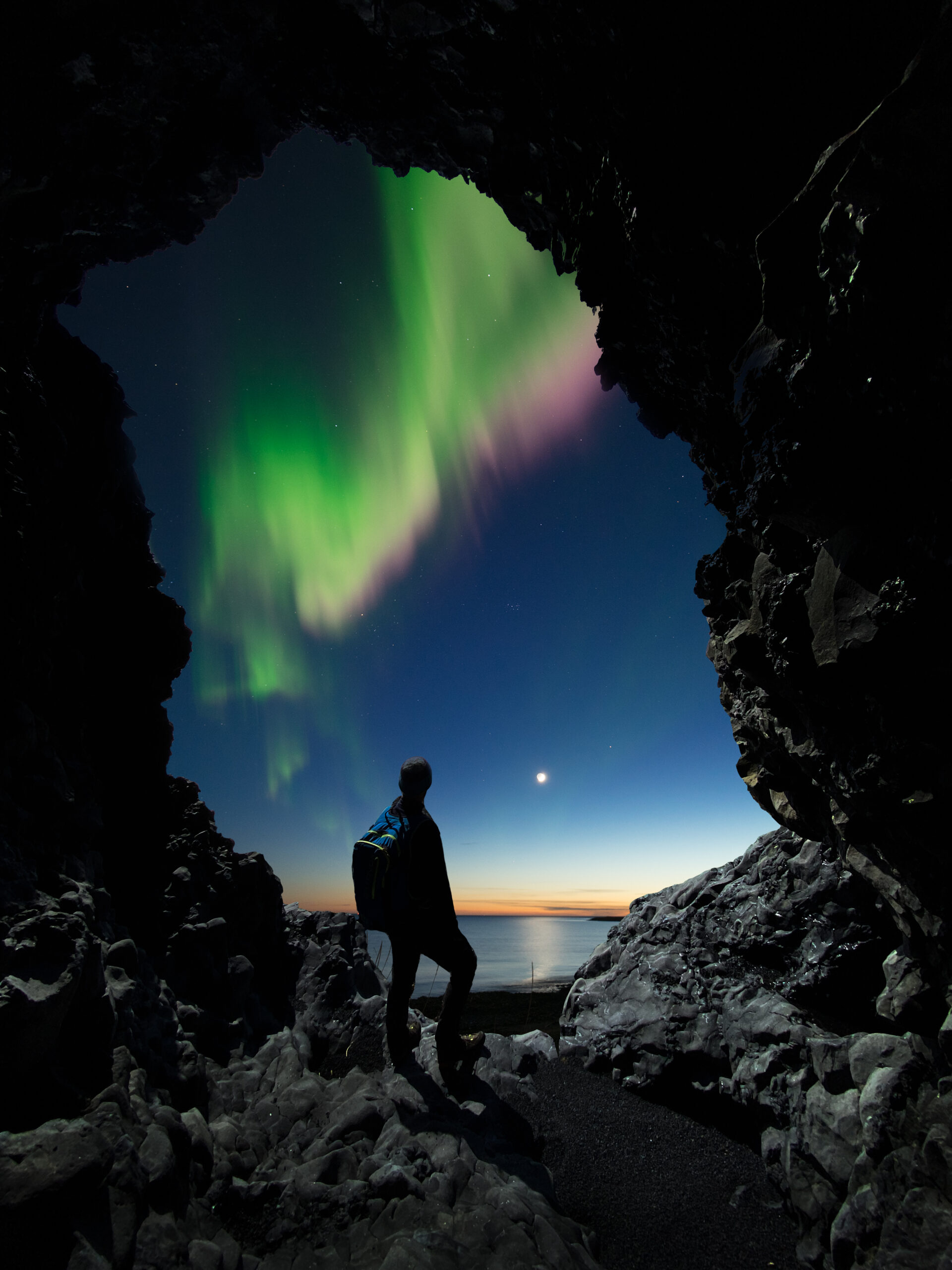
Aurora Boreal en Skógafoss
Hunting for the Northern Lights is always an adventure, and witnessing a display of this magical phenomenon will last in your memory for a lifetime.
Tell us about your experiences in the comments!
Únete a un tour guiado para ver Auroras Boreales
FAQs About the Northern Lights
1. Can I see the Northern Lights in summer?
No, the midnight sun in summer makes the sky too bright for aurora visibility. Plan your trip for winter months.
2. What colors can I expect to see?
Green is the most common color, but under strong solar activity, you may see pink, red, and purple.
3. Are the Northern Lights guaranteed?
While auroras occur every night, visibility depends on weather and solar activity. Many tours offer a retry guarantee if you don’t see them.
External Resources
Enhance your aurora knowledge with these trusted resources:
- NOAA Aurora Forecast – Real-time updates on geomagnetic activity.
- Space.com Northern Lights Guide – Learn about the science behind the aurora borealis.
- Visit Iceland Official Site – Plan your trip to Iceland with ease.
By following this guide, you’ll be well-prepared to experience one of nature’s most magical displays. Whether you’re planning your trip or already in Iceland, the aurora awaits!

